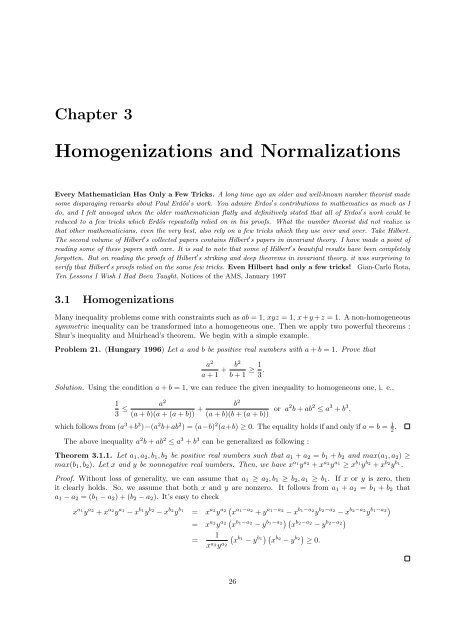Topics in Inequalities - Theorems and Techniques Hojoo ... - Index of
Topics in Inequalities - Theorems and Techniques Hojoo ... - Index of
Topics in Inequalities - Theorems and Techniques Hojoo ... - Index of
Create successful ePaper yourself
Turn your PDF publications into a flip-book with our unique Google optimized e-Paper software.
Chapter 3<br />
Homogenizations <strong>and</strong> Normalizations<br />
Every Mathematician Has Only a Few Tricks. A long time ago an older <strong>and</strong> well-known number theorist made<br />
some disparag<strong>in</strong>g remarks about Paul Erdös ′ s work. You admire Erdos ′ s contributions to mathematics as much as I<br />
do, <strong>and</strong> I felt annoyed when the older mathematician flatly <strong>and</strong> def<strong>in</strong>itively stated that all <strong>of</strong> Erdos ′ s work could be<br />
reduced to a few tricks which Erdös repeatedly relied on <strong>in</strong> his pro<strong>of</strong>s. What the number theorist did not realize is<br />
that other mathematicians, even the very best, also rely on a few tricks which they use over <strong>and</strong> over. Take Hilbert.<br />
The second volume <strong>of</strong> Hilbert ′ s collected papers conta<strong>in</strong>s Hilbert ′ s papers <strong>in</strong> <strong>in</strong>variant theory. I have made a po<strong>in</strong>t <strong>of</strong><br />
read<strong>in</strong>g some <strong>of</strong> these papers with care. It is sad to note that some <strong>of</strong> Hilbert ′ s beautiful results have been completely<br />
forgotten. But on read<strong>in</strong>g the pro<strong>of</strong>s <strong>of</strong> Hilbert ′ s strik<strong>in</strong>g <strong>and</strong> deep theorems <strong>in</strong> <strong>in</strong>variant theory, it was surpris<strong>in</strong>g to<br />
verify that Hilbert ′ s pro<strong>of</strong>s relied on the same few tricks. Even Hilbert had only a few tricks! Gian-Carlo Rota,<br />
Ten Lessons I Wish I Had Been Taught, Notices <strong>of</strong> the AMS, January 1997<br />
3.1 Homogenizations<br />
Many <strong>in</strong>equality problems come with constra<strong>in</strong>ts such as ab = 1, xyz = 1, x+y +z = 1. A non-homogeneous<br />
symmetric <strong>in</strong>equality can be transformed <strong>in</strong>to a homogeneous one. Then we apply two powerful theorems :<br />
Shur’s <strong>in</strong>equality <strong>and</strong> Muirhead’s theorem. We beg<strong>in</strong> with a simple example.<br />
Problem 21. (Hungary 1996) Let a <strong>and</strong> b be positive real numbers with a + b = 1. Prove that<br />
a 2<br />
a + 1 +<br />
b2<br />
b + 1 ≥ 1 3 .<br />
Solution. Us<strong>in</strong>g the condition a + b = 1, we can reduce the given <strong>in</strong>equality to homogeneous one, i. e.,<br />
1<br />
3 ≤ a 2<br />
(a + b)(a + (a + b)) + b 2<br />
(a + b)(b + (a + b)) or a2 b + ab 2 ≤ a 3 + b 3 ,<br />
which follows from (a 3 +b 3 )−(a 2 b+ab 2 ) = (a−b) 2 (a+b) ≥ 0. The equality holds if <strong>and</strong> only if a = b = 1 2 .<br />
The above <strong>in</strong>equality a 2 b + ab 2 ≤ a 3 + b 3 can be generalized as follow<strong>in</strong>g :<br />
Theorem 3.1.1. Let a 1 , a 2 , b 1 , b 2 be positive real numbers such that a 1 + a 2 = b 1 + b 2 <strong>and</strong> max(a 1 , a 2 ) ≥<br />
max(b 1 , b 2 ). Let x <strong>and</strong> y be nonnegative real numbers. Then, we have x a1 y a2 + x a2 y a1 ≥ x b1 y b2 + x b2 y b1 .<br />
Pro<strong>of</strong>. Without loss <strong>of</strong> generality, we can assume that a 1 ≥ a 2 , b 1 ≥ b 2 , a 1 ≥ b 1 . If x or y is zero, then<br />
it clearly holds. So, we assume that both x <strong>and</strong> y are nonzero. It follows from a 1 + a 2 = b 1 + b 2 that<br />
a 1 − a 2 = (b 1 − a 2 ) + (b 2 − a 2 ). It’s easy to check<br />
x a 1<br />
y a 2<br />
+ x a 2<br />
y a 1<br />
− x b 1<br />
y b 2<br />
− x b 2<br />
y b 1<br />
= x a 2<br />
y a 2 ( x a 1−a 2<br />
+ y a 1−a 2<br />
− x b 1−a 2<br />
y b 2−a 2<br />
− x b 2−a 2<br />
y b 1−a 2<br />
)<br />
= x a2 y ( a2 x b1−a2 − y b1−a2) ( x b2−a2 − y b2−a2)<br />
1 (<br />
=<br />
x a 2 y<br />
a 2<br />
x<br />
b 1<br />
− y b ) ( 1<br />
x b 2<br />
− y b ) 2<br />
≥ 0.<br />
26

















